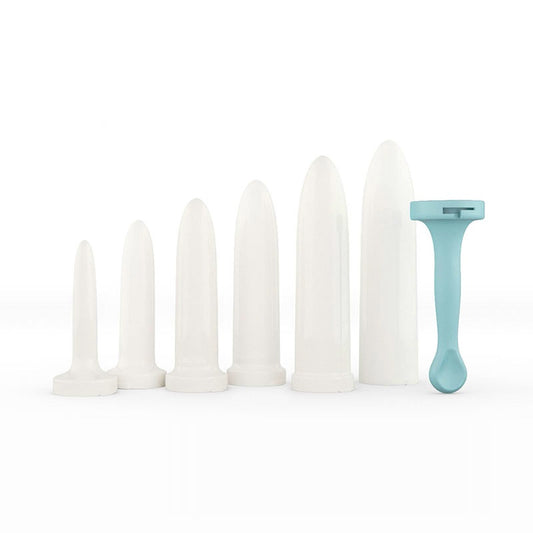
Diagnosis
Sexual Pain Evaluation
Seeking a Diagnosis
-

Confirmation
Women often suspect they have vaginismus from their symptoms and ideally will confirm the diagnosis with a physician.
-

Elimination
There is no direct test for vaginismus. One of the most important aspects of diagnosis is the thorough elimination of other possible physical or medical conditions that may be causing painful intercourse. Often a pelvic exam will be given to rule out other possible causes.
-

Education
Physicians are sometimes uninformed about the condition and it can be challenging to obtain an accurate diagnosis. Be proactive in educating yourself and seeking answers.

Q&A
Q: I can complete a pelvic exam without issue. Yet, intercourse is painful. Could I have vaginismus? A: Yes, not all women who have vaginismus have difficulty with pelvic exams. Q: What does it mean if the doctor is unable to insert her finger or speculum because my vagina is so tightly closed? A: Typically, you will be given a diagnosis of vaginismus.

Before Your Doctor Visit...
No one understands your pain quite like you. Before your appointment, make a list of your specific symptoms. For example:
It happens when...“my husband attempts to enter me.”
The pain is located...“at the entrance, my vagina is like a wall; he just cannot get it in/all the way,” or “after he’s inside I feel burning.”
The pain lasts...“as long as he keeps trying, especially if we try forcing it in. Once he stops there is no pain."
It feels like..."burning, stinging, hitting a wall."
Fixes I have tried..."using lubricant, changing positions, relaxing more."
Happening since..."our honeymoon two years ago" or "my hysterectomy five months ago."
Mention any other issues…“vaginal dryness, childbirth trauma,” etc.
The Pelvic Exam
Easing the exam experience
- Bring a friend or ask for nurse support.
- Request the smallest size of speculum.
- Ask your doctor to describe what is being done as it is happening.
- Ask to adjust your body positioning for maximum comfort.
- Relax your stomach, thigh, and buttock muscles. Breathe slowly and deeply.
- Speak up in response to overt pain or discomfort, and only continue at your discretion.
- Distract yourself by focusing on something else like a picture in the room or talking with your support person.
What takes place in a pelvic exam?
A typical pelvic exam involves two parts: a visual examination of the outer genital area and an internal exam using a speculum and/or finger. The exam takes place while you are lying on your back on an exam table with your knees spread apart. Your abdomen and thighs are covered with a paper sheet or blanket.
Note: Some women will not be able to complete the pelvic exam due to involuntary vaginal tightness. This is a common symptom of vaginismus and will be taken into account by the doctor during the diagnostic process.
External Exam: The doctor will visually inspect the outer genitalia, which includes the clitoris, vaginal opening, urinary outlet, and the labia. Any signs of unusual redness, discharge, irritations, or growths the doctor notices are recorded. A cotton swab may be used to touch several spots around the vaginal area to check for any spots sensitive to pain, which you will confirm.
Internal Exam: When vaginismus is suspected, doctors will often begin the internal exam by inserting one or two lubricated fingers into the vaginal opening to see if there is any resistance and to check for any tenderness or abnormalities along the vaginal walls. Depending on how the finger insertion goes, the doctor may then move on to inserting a speculum.
The speculum is a tool that separates the walls of the vagina so that the vagina and cervix can be clearly visualized for examination. To increase comfort, most doctors lubricate and warm the speculum to body temperature before inserting it. You may feel a slight pressure as the speculum is opened to widen the vagina.
A small spatula or tiny brush is then used to collect cells from the cervix for a Pap test or Pap smear. This test, conducted in a laboratory using the sample, screens for any abnormal cervical cells. You may feel a cramping sensation as the doctor collects the sample. Cultures of cervical discharge may also be taken using a swab. After the needed samples are collected, the speculum is removed.
A pelvic exam also includes assessment of the shape and/or size of the uterus, as well as a check for any fibroid growths, cysts, and/ or signs of infection. For this part of the examination, the doctor may place two fingers into the vagina while pressing down on the uterus.
Surgery doesn't cure vaginismus
Physicians encountering a tight opening may suggest surgery instead of recognizing the presence of vaginismus. Typically, women with vaginismus have normal genitalia. The vaginal muscles simply tighten up and then return to a relaxed state once the threat of penetration is over.
Surgery is not necessary nor helpful in treating vaginismus. The potential for muscle and tissue damage, scarring, and recovery pain of these types of surgeries only leads to more issues.
Sometimes, tightness is misdiagnosed as a hymen problem with a prescribed solution of a hymenectomy. However, hymen problems are rare. By adulthood, the hymen (if still present) is normally thin and elastic and does not prevent intercourse.
Seek a second opinion if any surgery to widen the vaginal opening has been recommended.
Other Causes of Sexual Pain
-

Some additional causes of painful intercourse are listed. These conditions can trigger vaginismus, which may persist even after the original condition has been resolved. See FAQ for more details.
-
- Eczema/Dermatitis (Vulvar)
- Endometriosis
- Interstitial Cystitis
- Lichen Sclerosus
- Ovarian Cyst
- Pelvic Inflammatory Disease (PID)
- Post-Surgical Trauma/Scarring
- Psoriasis
- Sexually Transmitted Diseases (STD)
- Trauma of Vagina during Childbirth
- Vaginal Atrophy (Atrophic Vaginitis)
- Vaginal Irritation
- Vaginal Prolapse
- Vulvar Cancer
- Vulvodynia
- Yeast Infection

Overcoming Vaginismus
Fortunately, vaginismus is fully treatable. Women can gain control over their vaginal muscles and override the limbic system reaction that causes the tightness. Recovery from vaginismus means having unhindered, normal sexual intimacy and pleasure.
Products
-
Hope&Her Vaginal Dilator Set
Regular price $49.00Regular priceUnit price / per -
Completely Overcome Vaginismus - eBook
Regular price $17.00Regular priceUnit price / per -
Hope&Her Private Zoom Support Groups
Regular price $110.00Regular priceUnit price / per -
Completely Overcome Vaginismus - Paperback
Regular price $21.00Regular priceUnit price / per








